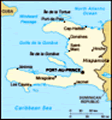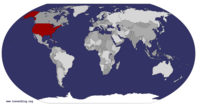Advertisement
Published: November 18th 2008
Our time for the clinic in Belle Anse was limited so we had decided to leave directly from the airport and get to Belle Anse that first night. In theory it was possible, but I began to have second thoughts when, even my co-director Guesno Mardy, who generally thinks anything is possible, was a little hesitant. ( He had seen the road I had not).
Driving through Port au Prince for the first time is always a shock. So many people, so much happening, tap taps and woman selling food and everything else right beside the road. One of my favorites to see is the walking pharmacies, usually a big bucket or board plastered with pills still in the protected foil but out of the box, to go farther, or maybe, because most people can only afford one pill at a time.
Piles of trash are everywhere. We did see one brand new garbage truck picking up garbage,
( "skipping the Garbage-Can stage" as Maggie said) in PaP, but in general there is no regular garbage pickup so it ends up all over and then being burned. The smells of diesel fuel and burning trash, mixes together to create an
overwhelming first impression. Not to mention the traffic, I have been told that other third world countries have the same sorts of traffic but Haiti is my only experience with traffic that has no, hard and fast rules. If the lane for on coming traffic looks like a better deal, than the right side of the road, you can take your chances and use it. It is not an exaggeration to say that there are wholes in the road that could swallow a car. It is exciting to drive in Haiti very similar to a very long lasting roller coaster ride, especially in that the best we can do is relax and enjoy the ride and have faith that we will all be fine in the end. And we always ( knock on wood) are.
Port au Prince is an amazing place but my favorite parts of Haiti are outside of that city.
As we left PaP we took the road that goes to Jacmeal, it crosses the mountains south of Pap to the other side of the island. On a road map it looks straight, in reality it is the opposite of straight. It winds up and then
down the mountain range that separates the two sides. It is green beyond what you would imagine for a country famous for erosion and deforestation. I have not seen every bit of the island, but I think from what I have seen, that this southwestern leg of Haiti has less erosion than the upper northern part. At least here we see big Moab and other trees and less of the terrible large rocky scars and naked mountains that I have seen in the north. Although we could still see where erosion and the recent hurricane season took it's toll on the area we were travelling through.
As we climbed high into the mountains of Haiti it is spectacularly beautiful. With agricultural plots anywhere a person can stand. People of all ages are working the land and carrying water or large bundles along the road, throughout our journey. Beautiful small pink or yellow and tourquoise houses made of stucko or cement with tin roofs line the road in each village. Outside in the country the houses are often made of sticks and thatch covered with mud some with dirt floors some with cement.
We made it to Jacmeal just
as the sun was setting. It is a beautiful town, along the sea with a river running through. the river bed now mostly empty is 3 or 4 times larger than the last time I passed through. The damage the hurricanes wrought this year was apparent everywhere we went in our trip. The road from PaP to Jacmeal had several places where hillsides had fallen and had been cleared enough to let a machine get through. Commerce in Haiti depends on the ability to get charcoal and food products from the rural areas to the cities, the highways are vital to everyone's survival. The closing of so many roads because of the damage done in the rainy season is a very real threat to the survival to those already most at risk, children, elderly, and sick people who already don't have enough to eat. Guesno told me that in the area of Belle Anse 14 people had died in the month before we arrived.
Back to Jacmeal, the thing I love about Jacmeal and La Cayes ( and older parts of PaP) is the architecture. Many of the buildings are victorian and made of wood. The streets in the
downtown areas are thinner and taller, there is a since of Haiti's history that I don't get in much of the concrete and cinderblock modern homes and buildings of Haiti ( and other parts of the Caribbean).
We stopped to get gas it is a happening place the gas station. ( By the way fuel prices have not gone down a bit as they have in the US and are around $6 a gallon (Or litre?). A big change since my last visit is that motorcycles are being used as taxi much more than before. There are hundreds of brand new looking motorcycles driving two or three or even 5 people, around town. I wish I had gotten a picture of one carrying 4 or 5 beautiful children to school in their matching brightly colored uniforms.
The drive over the mountain had made a few of our intrepid travelers car sick.
So Dr Cesar, our Haitian Doctor, on the medical team, gave up his seat in the front of a machine to ride in the back of the truck with about 6 other guys, all perched non-challantly on top of our luggage and supplies. It looked like fun
at the time and I thought about sending my son out to join them. Later that night I was glad I had not, because I would have been terrified to think of him bouncing up and down the roads we would pass through.
From Jacmeal to Belle Anse in the dark, now seem more dream or movie I watched than something we lived through. The roads were passable we did make it through, but just barely on many occasions. The general conditions of roads in Haiti, and on top of that the damage from the rainy season, kept our top speeds at about 30 to 45 miles an hour, which seemed REAllY fast. Most of the time our top speed was more like 10 to 20 mph. The car I was traveling in was full of young peple so we were listening to loud Haitian and rap music as we blasted down the road. Coming to a complete stop for speed bumps in villages, landslides or roads washed away or giant ditches or rivers or detours through small neighbor hoods. A few times the truck came to a complete stop seemingly unable to get up the hill or over
the ditch, then someone would get out and turn the hubs to shift into four wheel drive ( which was surprising ...... we weren't already in 4 wheel drive?) But four wheel over drive is saved up for the really important occasions.
The villages we passed through do not have electricity, occasionally an open business would have a generator, but the lights we saw where primarily from oil lamps on tables of venders beside the road or coming from the inside a home. Very beautiful, with so much light coming from everywhere back home, it seemed like a dream and magical to see the world in this other light. Our headlights ( and loud music) didn't seem to create much more than a ripple in all the activity that was going on all along the road.
It was a great adventure getting to Bell Anse, I think everyone on the medical team enjoyed it. I really great extended roller coaster ride, with equal amounts of fear and joy that on a roller coaster take about 5 minutes, lasted about 3 hours for us. We were hungry and tierd and glad to be holding still by the time we
arrived.
Bell Anse seemed asleep as we drove down it's main street, with only one wrong turn, we found the gates to the school we would be staying at. It is a new school built two years ago by a Haitian government program funded by the the world bank ( or some group similar which will expect to be paid back) to create schools in Haiti, it is well built and beautiful but unfinished and under utilized because most people can not afford to send their children to school, at all, even a public school. The tuition for this school was cut in half from the previous year to increase enrollment and still it is about half empty. We do have a plan to increase enrollment. A lunch program the French group POM has committed to providing the dry goods rice and beans pasta etc, for a meal program. Sionfonds is going to find funding to build a kitchen and get the other things needed to feed the children (like plates and spoons and kitchen supplies and other foods needed, pay for the cooks etc) That will increase attendance and help all the students be able to learn.
At
the Sionfonds run schools that we visited it was also stressed that the thing they need most, even more than walls on the classrooms or chalk, or pencils, was food for the children. Even just bread and powdered milk would make a tremendous difference in attendance and the ability of each child, to learn.
For us there was a beautiful and excellent meal waiting, that night. Sionfonds staff had made several trips to Belle Anse to bring food water and staff to cook for us. Which is why they knew the road was passable, at the times that I was pretty sure it was not!
After our meal we broke out our camping gear , cleared out a large classroom and made camp. sleeping bags, air mattresses and mosquito nets and bug spray, too, because malaria and other diseases that are not an issue in other parts of the Caribbean are still in Haiti.
I am pretty sure we all slept well and most of us woke with the roosters crows at first light
-except the teens of course-.
I will stop here, Already I have written so much and just getting to the clinics. Thanks for
reading, I am writing this for all Sionfonds supporters and for myself too. Being back home, the day to day living here, pushes out of my mind all the amazing adventures we had on our trip and I want to remember and share them with our friends and donors who made all of it possible. It is my gift to share with you, as a way of saying, thank you.
more soon
annie
Advertisement
Tot: 0.131s; Tpl: 0.022s; cc: 9; qc: 49; dbt: 0.0696s; 1; m:domysql w:travelblog (10.17.0.13); sld: 1;
; mem: 1.2mb








